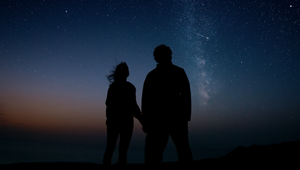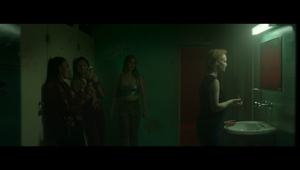
Seeing All the Angles

Academy Award-winning artist and filmmaker Robert Stromberg is renowned for his unique storytelling voice and aesthetic, seen in his work across film and television, commercials and branded entertainment. He has been honored with two Academy Awards, including one for Production Design (with Rick Carter) on James Cameron’s Avatar, and won multiple Emmys, among them two for Outstanding Visual Effects for “Boardwalk Empire.” As a commercial director, he’s taken home a Cannes Silver Lion for “The Martian VR Experience,” produced by Ridley Scott, and a Bronze for the branded series “What Lives Inside” for Dell + Intel with agency Pereira O’Dell.
In the visual effects realm, Robert has collaborated on a long list of hits, everything from “Game of Thrones” to From Dusk Till Dawn. (imdb) His directorial feature debut was Disney’s Maleficent with Angelina Jolie, which was the highest grossing film by a first-time feature director. He’s directed Super Bowl commercials for Mercedes and Pepsi’s Lifewtr, and his latest commercial film, “The World is on Netflix” debuted during the Summer Olympics.
We spoke with Robert about working his way up the ranks as a storyteller, takeaways from some of his favorite projects, advice to aspiring filmmakers, his upcoming feature and documentary film projects, and more.
Q> What were your inspirations for developing the characters featured in the Netflix commercial “The World is on Netflix?”
Robert> In my career I’ve been associated a lot with science fiction and fantasy projects. I’ve also loved classic films and films that touch the human spirit, so this Netflix commercial was a nice blend of the two.
I’ve always enjoyed the process of developing CG characters and Maleficent was an inspiration. In that film, I created a lot of concept work for the creatures of the fairy world, and I used what worked best and allowed the ability to experience a range of emotions. In the Netflix commercial, the alien eyes needed to look photo-real, and the faces expressive, to display anger and joy in their emotional journey. The aliens come to Earth to judge humanity. In the first part the leader is swiping through clips which appear to show Earth as overcrowded and aggressive, and we can clearly see that this upsets the alien viewer. When he stumbles upon the Netflix content, he begins a journey into understanding humanity. Anger becomes empathy and that’s a really big character arc to convey in just sixty seconds.
I enjoyed working with The Mill building the characters, they did a great job making the animation process time efficient. And this was my first ad campaign with Netflix. It was a pleasure to work with their creative team, led by [VFX producer] Marcus Taormina.
LBB> Tell us about the collaboration.
Robert> Start to finish about twelve weeks, and that includes initial script approval, environment concept/creation, storyboards, pre-viz and finally character design/creation. It’s amazing what can be done using wire frame characters to develop the story and each week adding more detail to help the characters come alive in their unique environment. I stayed on the project well into the final VFX approvals; for me, investing in the design, concept and creation is not finished until the visual effects are complete. Seeing through the subtle tweaks in facial details for maximum impact was important right up to final delivery.
LBB> What tactics do you use as a director or VFX artist to have your CG/animated stars’ performances convey emotion so the audience empathizes?
Robert> Our task was to create relatable characters that would seamlessly intercut with the live action clips from the Netflix vault of content. In order to accomplish this, I had to treat the CG characters as if they were actual actors in a scene. Of course, they aren’t real, but their emotions are emulated from real people. It is my job to connect with the animators and to act out or talk through what creates these emotions and by directing the animators we direct the character.
LBB> What did you enjoy most about being a matte artist early in your career, and how did that craft serve you in your career?
Robert> I always feel blessed that I have had such a rich past in not only VFX and art direction but also a love of characters and how they interact with one another. Matte painting allowed me to design single shots that seamlessly integrate into film scenes; this meant I had to know the scene, the specific shot, the environment, the emotional tone and the characters, specifically what they are reacting to. Studying all aspects of the shot and film overall provides experience and understanding of how everything fits together, and teaches you the skills of directing.
There is still a lot more to learn to direct a film and by observation those skills can be learned, specifically how to direct actors to deliver the performance necessary for each scene. With my experience in all aspects of film, on set I can easily discuss production design and visual effects, camera angles and solutions to save time and money to accomplish the goal. For me, rising through the ranks was the best way to arrive at directing. It was a natural progression.
When I directed Maleficent, I personally created more than one hundred matte paintings, and this helped guide the creative direction and provided input to the VFX process. It was also a way for me to leave my personal visual fingerprint on the film.

LBB> What’s your relationship with evolving technology and creativity?
Robert> I’ve always loved the idea of using technology and creativity in new ways. In the film Avatar, we were inventing technology along the way to deliver cutting-edge content. We were the first to integrate actual production of a virtual world with a virtual camera. James Cameron and I would often joke that “We should know what we are doing by the time we finish this thing.”
Early on in my career, I witnessed film evolve from analog to digital. It was an exciting process to watch and learn how technology eventually replaced traditional film. It took time to convince the die-hard filmmakers to let go of the tactile film product and engage with digital. It was an expensive transition for this industry to upgrade and replace film equipment, but once digital was here it was here to stay.
At first, technology was cumbersome and foreign to artists. When I first started using Photoshop, I invested in the best computer technology and even then it would take a full minute to render just a few pixels. At the time, the act of physically creating a matte painting was a lot quicker. However, I knew if I didn’t learn to transition my skill into a digital format that I would be irrelevant in a matter of time. I attribute Moore’s law to the success in the advancements in computer technology and my willingness to keep learning computer graphics, and with the advancements year after year in better and cheaper technology that made it possible to continue advancing the digital film industry.
Technology is powerful, but artists need to embrace it because it needs an operator to see the vision of what can be achieved. We accomplished that with Avatar.
LBB> Outside of commercials, what are you working on now?
Robert> Relativity is a film I’m attached to as the Director and it’s the story of Maleva Meric, Einstein’s first wife and how she helped develop the Theory of Relativity. I’m also working on a Rockabilly Documentary featuring many of the musicians known for their contribution to the music and those who have been influenced by the music.
LBB> What movie-making experience will you never forget?
Robert> There are unique experiences with every film project I’ve been involved with beginning with my first cinematography job at age 22. I was sent to Vietnam with 22 film cases, by myself, to capture B roll for a Credit Suisse commercial. Upon arrival all of my film equipment was confiscated, and I was left with just my luggage. So I set out to enjoy the city before I was allowed to film. It was a huge responsibility at such a young age and I learned a lot about time management, utilizing limited resources and dealing with foreign governments.
The most unique film I’ve worked on was Avatar. That four-and-a-half-year journey was filled with challenges figuring out how to merge the CG world with actors as characters. Using a studio of props covered in grey paint and our actors in motion capture suits, we captured their body movements and expressions to map to the CG characters for the ultimate real-life animated scenes. Spending days and weeks in The volume”* and alternately working on an animated world to view through a virtual camera at the same time was all mind blowing. (The Volume is the motion capture stage we used to virtually film in. There are hundreds of infra-red cameras placed around the stage which pick up the reflective material on the joints of the actors special motion capture suits, this creates a digital skeleton in the computer which then drives the digital character CG model in real-time.) Even explaining it is hard to imagine with the advancements in technology today. Back in 2005 it was all new to everyone and we pushed the envelope to use the most of what was available. I’m proud of what we accomplished in Avatar. It was the first film of its kind.
My first major film directing project, Maleficent, took me to a level I once only dreamed about. I found myself on one of eight sound stages at Pinewood Studios. I was working with an A-list celebrity, Angelina Jolie, strategizing together on different scenes, watching her fly across the stage performing her own stunts and positioning the camera crane out in the fields of England with one hundred extras prepared to battle in a scene that only had one take. It was all so thrilling to direct.
When the film debuted, I was fortunate to receive the recognition of having the highest grossing film for a first-time director.
LBB> How about a standout experience making a commercial or branded entertainment?
Robert> My sole focus when I take on a project is to build and grow memorable and relatable content, and every commercial or piece of branded entertainment I direct has special moments.
For instance, Dell, What Lives inside was a four-part series that allowed more time for character development. It was set in a whimsical, alternate world that I enjoyed developing. The message was very personal, the struggle to balance doing what you love for work and raising a family. In this film, Colin Hanks discovers a deep connection with his father. I’ve struggled with being apart from my children for periods of time to develop film projects and I resonate with Colin’s dad. It’s really hard to balance the two and ultimately you must provide for your family, and at a cost to give your children a better life with more opportunity.
A few of my other favorites include a commercial for Pfizer that was inspired by a research scientist who as a child was sick and dreamt of being part of a research team to find cures for childhood illness. That is exactly what she did and having a chance to meet and film her was a highlight. She was an inspiration to me and I felt synergy in knowing we both realized our childhood dreams in finding a passion for doing what we loved.
Another favorite was a recent commercial for Taco Bell. We were challenged to find an authentic Opera house during Opera season, and the RSA Films’ team did an amazing job with the selection. We traveled to Poznan, a small town in Poland, to use a beautifully preserved opera house for a festive circus of entertainers. We put actors on wires floating through the air tasting Taco Bell Chalupas. The energy in the room was unforgettable, the excitement of watching the jugglers and fire breathers, the acrobatics and contortionists all coming together under a flood of confetti performing for the commercial’s grand finale.
LBB> What type of projects are you most interested in now in commercials or branded content?
Robert> I love the challenge of creating something new, whether that is an environment, character or concept. I’m interested in trying a new approach or angle to freshen the brand and I like to get involved with the storyline and art concepts before we get into the actual production. Commercials have such a limited amount of time to tell a story, and it’s that limited time that can sometimes be exciting. How do we show a character arc or create an emotional connection, and ultimately create a memorable 60 or 90-second commercial in such a small space of time? I love a good challenge.
Branded content for Netflix and Hulu, and my all-time favorites working with Chris Hemsworth making a commercial for Bayut in Dubai, and in London with Chris for Emirates Airlines for the World’s Fair Expo in Dubai 2021-2022. I’ve enjoyed working with a number of brands - physical products such as Lifewtr, Mercedes-Benz and Taco Bell, lifestyle vignettes for Pfizer, Eli Lilly, Neurocrine, AstraZeneca and Vanda.
LBB> Any advice for aspiring directors who begin their journey in the art department or visual effects?
Robert> Pay attention to the details in life, this means every aspect of it. The way light affects an environment, the way we interact with one another, how does the camera move and how can it aid in certain situations? Understand how flow and pacing dictate how we should feel. Someone once asked me “What makes one person an artist and another person not an artist?” I would suggest that an artist pays attention to the details that others don’t really care about. Call it an abundance of curiosity but it’s all of these micro details that give us the ability to push through creative problem solving whether that inspiration is in plants or wildlife, or just a common exchange between two people at a coffee shop or in a mall. Knowledge will always be the path to the creative finish line.
Of course, it takes passion and drive to move up the ranks to achieve the level of success that you desire. It’s not a race, it’s a journey to wherever you want to go, and deciding how to get there. For me I always wanted to be a director, that was my ultimate goal, and I forged a path to get there. It wasn’t always easy, in fact it was mostly really challenging. But I enjoyed learning and that kept me focused on understanding how things work and on challenging myself to take the leap of faith to advance toward my goal. Anyone can do whatever they set their mind to and I’m living proof!















